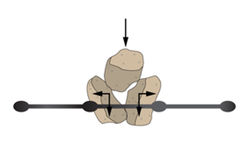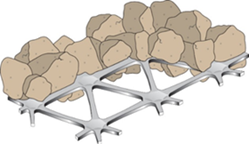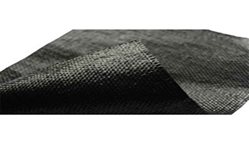Geogrid Construction & Civil Engineering Resources
Looking for more resources? Here you'll find our educational pieces like blog articles, webinars, and videos. You can also download product specifications and other key construction documentation.
2500 Northwinds Parkway, Suite 500
Alpharetta, GA 30009
Customer Service
800-TENSAR-1 (Toll Free)
770-344-2090 (International)
2500 Northwinds Parkway, Suite 500
Alpharetta, GA 30009
Customer Service
800-TENSAR-1 (Toll Free)
770-344-2090 (International)
Looking for more resources? Here you'll find our educational pieces like blog articles, webinars, and videos. You can also download product specifications and other key construction documentation.
There are no results that match your search. Please try another search or Contact Us with further questions.
There are no results that match your search. Please try another search or Contact Us with further questions.
There are no results that match your search. Please try another search or Contact Us with further questions.
There are no results that match your search. Please try another search or Contact Us with further questions.
There are no results that match your search. Please try another search or Contact Us with further questions.
There are no results that match your search. Please try another search or Contact Us with further questions.
There are no results that match your search. Please try another search or Contact Us with further questions.
No. Geogrid strength does not correlate to in-ground performance, which has been demonstrated in multiple studies (Watts et al., 2004 & Giroud & Han, 2006). The ability of the geogrid to interlock and confine the aggregate subjected to traffic loading is fundamental to deliver enhanced performance of the mechanically stabilized layer (MSL). This enhanced performance can only be measured through full-scale in-ground trafficking testing. Geogrid characteristics such as rib shape, aperture shape, polymer type and material structure configuration, rib thickness, in-plane stiffness, junction shape, geogrid-aggregate compatibility and many other factors are contributors to the amount of interlock and confinement achieved, and therefore, enhanced performance of the MSL.
No, they don’t. Aperture shape and size are key parameters to allow interlock between the particles of the granular fill material and the geogrid. However, other geogrid properties such as the rib height, rib width, rib aspect ratio, rib material, geogrid in-plane stiffness, and relative location of the rib with respect to the center of mass of the granular fill particles are key to delivering improved performance of the mechanical stabilized layer (MSL). Having the right shape of rib is also fundamental to the performance of the system.
Geogrids must have a minimum tensile strength to make sure the product is not damaged during the installation and compaction of aggregate. However, no correlation has ever been shown to exist between tensile strength and the performance of geogrids used for roadbed applications. This has been demonstrated in multiple studies (Watts et al., 2004 & Giroud & Han, 2006).
No, InterAx geogrids work differently than TriAx or BX geogrids because of InterAx’s unique structure, its wide range of aperture shapes and sizes, and the interactive outer layers. By having a geogrid structure with multiple aperture shapes and sizes, particles of different types of fill materials can interlock and interact more efficiently with InterAx. This geogrid/particle interaction is enhanced by InterAx’s interactive outer layers, which conform to the shape and angularity of the particles of the fill material. These characteristics enhance the load distribution onto the subgrade, mitigating subgrade deformation and early failure of the mechanically stabilized layer (MSL). Lastly, since different types of geogrids have different structures, material characteristics, and performance properties, geogrids are not interchangeable without revising the design.
Biaxial geogrid was invented by Tensar in the late 1970s. Biaxial geogrids have square or rectangular openings, called apertures. Different types of biaxial geogrids exist on the market, but for roadbed applications, testing has consistently shown that integral geogrids made by a process known as punched and drawn perform best. In 2007, Tensar introduced multiaxial geogrids, known as TriAx. These geogrids have triangular apertures and ribs with a higher aspect ratio than biaxial geogrids. This geometry provides better interlock with the surrounding aggregate than biaxial geogrids, resulting in improved performance in stabilization applications. In 2021, Tensar introduced InterAx geogrids. InterAx builds on the decades of knowledge and testing at Tensar to deliver a higher level of performance. Through thousands of hours and millions of dollars of research and development, we combined advanced materials science, a revolutionary new geometry, extensive performance validation testing, and an entirely new design approach to deliver better solutions that are more economical, longer lasting, more resilient, and more sustainable.
| Characteristic | InterAx | TriAx | BX | |||||||||||||||
| Development | InterAx geogrids were introduced in 2021, representing a significant leap forward in geogrid design and materials | TriAx geogrids were introduced in 2007, which marked an advancement in geosynthetic technology | BX geogrids have been around since the late 1970s | |||||||||||||||
| Generation | Third | Second | First | |||||||||||||||
| Aperture Geometry | Triangular, Hexagonal, Trapezoidal | Triangular | Square | |||||||||||||||
| Material Structure | Coextruded - Three Layers | Monolithic - Single Layer | Monolithic - Single Layer | |||||||||||||||
| Stabilization Direction | Longitudinal, transverse, and diagonal | Llongitudinal, transverse, and diagonal | Longitudinal and transverse | |||||||||||||||
| Performance | Best load distribution and interlocking capabilities with various types of fill materials | Adequate load distribution and interlocking capabilities | Limited load distribution | |||||||||||||||
| Performance Differential |
|
|
|
Geogrids are polymeric (plastic) construction materials used to confine and stabilize granular fill materials to increase their load distribution capabilities while reducing its potential to deform under load. Geogrids have openings called apertures, which allow for rock particles to strike through. This action is known as particle interlocking, and it allows for rock to become confined within the aperture.


Geotextiles are construction materials made from woven or non-woven polymeric (plastic) fibers. They can be used to provide filtration and separation, which restrains soil from mixing with adjacent materials due to dynamic forces. Geotextiles cannot confine granular fill materials, since there are no apertures to achieve particle interlocking.

Unless you are an expert in pavement design, it may be very difficult to evaluate all of the information that may be submitted to you – let alone find time to do so. Unscrupulous suppliers often try to take advantage of this fact by providing large quantities of information, even though it is not sufficient to show equivalency and may not even be relevant to the application. You can reduce the confusion by writing a project specific specification that includes the information outlined in the checklists we linked above – depending on the application (subgrade stabilization or designing a pavement).
Yes. There are different design methods and inputs for each design method. The allowable amount of permanent deformation also likely differs for both of these applications. They require different testing, and have significantly different failure criteria. Specifics on what to look for when comparing testing for subgrade stabilization and paved road design can be found in the FAQ below.
Performance is not based on index properties of the geogrid, measured in a lab. It is determined empirically, using full-scale in-ground trafficking testing. Request a copy of the design inputs and the design method which were used as the basis of equivalency. Also ask for the full-scale testing, with the specific product being submitted (not another “similar product”), and documentation from an independent authority verifying that the testing and calibration were performed properly. Once you have this information, you will be able to compare performance related sections and evaluate equivalency.
Performance is not based on index properties of the geogrid, measured in a lab. It is determined empirically, using full-scale in-ground trafficking testing. Require a copy of the third-party testing on which the supplier is basing its claim of equivalency. This testing should include Accelerated Pavement Testing (APT), performed on paved sections, following the procedures defined by NCHRP report 512. There should be multiple sections tested over different subgrade conditions and different pavement section thicknesses. Require a third-party review, by pavement design experts, verifying that the design values and methodology used are supported by testing for that product, and follow the guidance of AASHTO in R50-09 (“Geosynthetic Reinforcement of the Aggregate Base Course of Flexible Pavement Structures”). Also require third-party field validation testing, following AASHTO T221-90 (2012), to demonstrate that the results obtained in the field support the assumptions used in the design methodology, and that deformations are in line with predictions.
There are dozens of geogrids and other geosynthetic products on the market. How do you know which is right for your project's needs? When it comes to roadway construction, the keys are proper design and testing to validate performance.
.png)

There are no results that match your search. Please try another search or Contact Us with further questions.
Get contact information for your local distributor and get Tensar products on your jobsite today.